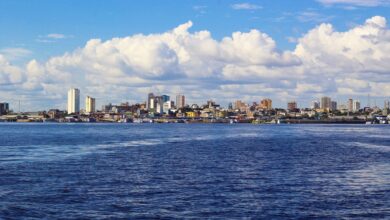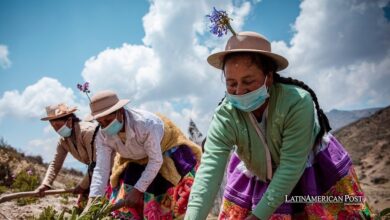Droughts in Latin America: Living with Less Water?
The Second Annual Report of the WMO Warns About the Serious Repercussions of Climate Change in Latin America. Experts Recommend the Adoption of Urgent Measures to Stop the Drought, which Endangers the Availability of Water Resources in the Region.

Photo: Pexels
LatinAmerican Post | María Fernanda Camisay
Escucha este artículo
Leer en español: Sequías en América Latina: ¿Vivir con menos agua?
Existence on our planet depends on water. Without this resource, the progress of society and the life of countless species would be impossible.
Alarmingly, the climate change crisis is altering the water cycle and, with it, the available water reserves. Not only are extreme weather events occurring with greater frequency and intensity, but also the availability and quality of water resources are greatly diminished.
In this regard, the United Nations highlights that no corner of the planet is safe from these consequences, and this inexorably includes Latin America. A new report from the World Meteorological Organization (WMO), a UN specialized body on climate and water cycles, reveals the profound impact of climate change on Latin America, which far from being a forecast, is a reality that threatens to worsen in the years to come. Droughts in Latin America today are an alarming reality.
Rain patterns are changing, temperatures are rising, and in different regions of the planet's Southern Cone, extreme weather events are occurring that are increasingly severe and recurrent, such as droughts, heat waves, intense rainfall, flash floods, hurricanes, and glacial melting.
This set of events affect food and water security, human health, poverty and the stability of natural ecosystems. "The Report on the State of the Climate in Latin America and the Caribbean 2021 shows that hydrometeorological risks have unfortunately caused the loss of hundreds of lives, serious damage to crop production and infrastructure, and human displacement," declared the WMO Secretary General.
Water scarcity in the world
Among the different climatic events that shake the region, drought is one of the quietest natural disasters, but one that is disruptive to sustainable development, according to the UN.
In fact, forecasts from this international entity suggest that by 2050, droughts will affect more than three-quarters of the world's population. The number and duration of this phenomenon has increased in the last two decades and to date, "more than 2.3 billion people suffer problems due to water scarcity."
These are, without a doubt, numbers that are worrying and reflect the current situation in the world. Europe is going through the worst drought in 500 years and Latin America is going the same way. In fact, its outlook is not at all encouraging, despite having countries with enormous biodiversity.
Also read: Drought in Europe: What Does the Future Hold For The Old Continent?
Since the turn of the century, water availability per person has decreased by more than 20% due to rapid population growth, strong demand from regional economies, and an unrelenting climate crisis.
Millions of farmers face frequent droughts that endanger their harvests and restrict crop transport due to low river flows. Likewise, the scarcity of water reduces the electricity produced from water sources, increases the probability of forest fires and limits the supply for domestic or consumption purposes.
Droughts in Latin America: the southern cone on alert
According to the WMO study, droughts in Latin America are a fact. One of the clearest examples of this corresponds to the mega-drought in Chile. Currently, Chile is experiencing more than a decade of drought, the worst in its entire history and the longest and most intense in the region in at least a thousand years.
With a water deficit that reached 60% of its territory last year, "there is a clear trend towards desertification that places this country at the head of the water crisis in Latin America." To understand the magnitude of this crisis, it is important to point out that this mountain country is sustained by two main sources of water: the reservoirs that, today, have critical levels of reserves given the lack of rainfall, and the accumulation of snow that is coming to an end.
The scarcity of water puts the agri-food industry in check. Furthermore, it endangers the reserves available for human consumption, with a good part of Chileans already living in conditions of rationing. Given these circumstances, future projections for Chile do not provide good news either. According to the General Directorate of Waters (DGA), there is a high risk that the drought will worsen and become the new normality of the country in the coming years.
Certainly, Chile is a great example of the terrible impact of the drought, although not the only one in the region. Parallel to the water scarcity of the Andean country, the Paraná – La Plata Basin, one of the largest in South America, is going through an extensive period of decline never before recorded. The absence of rain, mainly in the upper part of the basin that encompasses central-southern Brazil and parts of Paraguay, Bolivia and Argentina, has caused a significant reduction in the flow of the Paraná and Paraguay rivers, and by extension, in production. of crops in the area.
The fall in the levels of the basin is a great blow to the economy that forces ships to circulate with less cargo so as not to run aground. At the same time, it reduces the capacity of dams to provide hydroelectric power. Added to all this is the environmental damage caused by the downspout, with hundreds of aquatic species compromised and thousands of local inhabitants who use this water source on a daily basis and live with great concern.
Reducing the impact
In this context, the report highlights the need to strengthen the different links of climate services, including monitoring, early warning systems and action plan management, in order to reduce the risk of natural disasters.
It is clear that climate change is a serious threat and, at the same time, a great opportunity for humanity to better manage water resources and find ways to survive and prosper in an increasingly uncertain and changing world.




